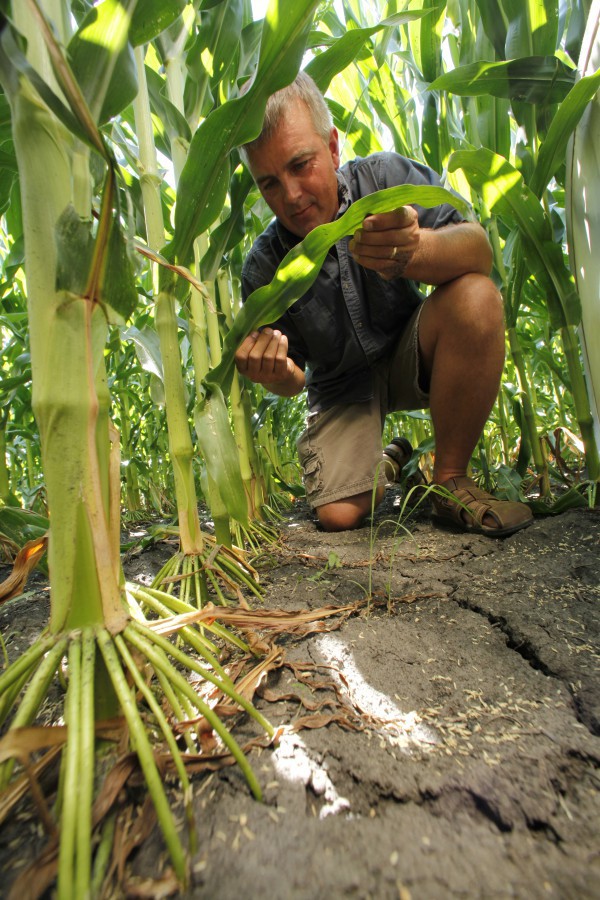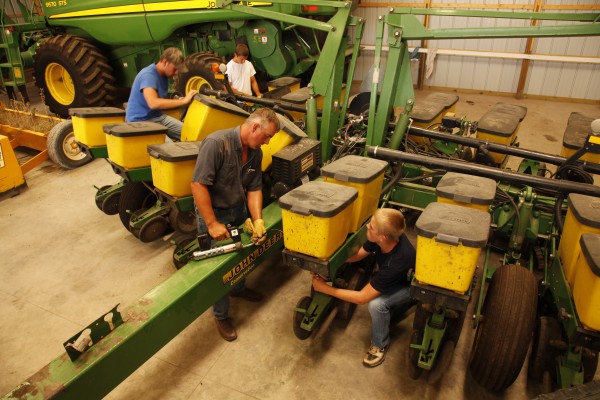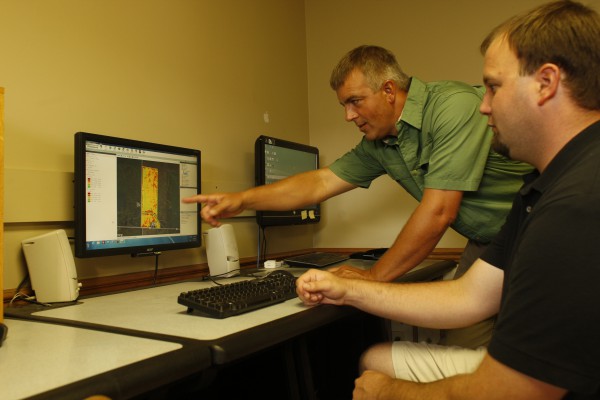Technology, split fertilizer applications and higher seed populations are putting Illinois strip-tiller James Schoff on the path to profitability.
Walnut, Ill., strip-tiller James Schoff isn’t one to shy away from a challenge, especially when it involves the potential of increasing yields and improving efficiency.
The fifth generation farmer — along with his two cousins and his father Ray — strip-tills about 1,300 acres of corn, no-tills about 700 acres of soybeans and uses conventional tillage on 700 acres of corn.

SPLIT THE DIFFERENCE. For years, Illinois strip-tiller James Schoff applied 100% of the farm’s nitrogen in the fall (180 to 190 units of anhydrous per acre), but he recently moved to a split-application (80 to 100 units in fall), which has allowed him to “put that fertilizer dollar where it’s going to be best utilized.”
Their first experience with strip-till in the early 2000s wasn’t necessarily a smooth one, so it’s taken time to develop a successful system that now includes precision technology, fertility program modifications and participation in a progressive yield-boosting program through Mosaic Co.
“Initially, we had a local farmer custom strip-till a few hundred acres of corn into soybean stubble, just to take a look at it,” Schoff says. “But it came with some challenges, mainly with the setup of the bars. They made nice strips, but in spring we struggled to visually see them and plant on top using markers.
“I can remember my Dad sharing frustration of whether or not this was going to work, because he just couldn’t see, and it depended on different light conditions and different times in the day.”
Equipment Evolution
The addition of GPS guidance dramatically improved their ability to stay on the strips, and despite the early concerns, the Schoffs saw enough potential in strip-till to purchase a 12-row DMI rig.
They used the rig for 3 years, primarily for building fall strips into soybean ground, but Schoff wanted to evolve the operation to do more corn-on-corn acres.
“When we started, we were pretty limited on what we could do in those conditions, just with being able to get the right amount of trash to feed through the bar,” he says. “There was some success, but definitely some early failures to going to corn-on-corn.”
In the market for a new unit, 6 years ago the Schoffs tested a 12-row John Deere 2510 strip-till rig and purchased a prototype model. The heavier bar, with row cleaners and mole knives, proved to be a good fit for their corn-on-corn ground.
“We farm quite a few fields that have rocks, so from a standpoint of time actually sitting in the tractor seat getting something done, vs. switching out shear bolts, it was a night-and-day difference,” Schoff says. “We were able to get more production that way, and we were able to go into any field conditions in a corn-on-corn situation and the trash would feed through.”
They prefer to run the mole knife 10 to 12 inches deep, depending on field conditions and how much down pressure is needed for the closing disks.
“We’ve got some sandy fields that we’re constantly putting down pressure on, or floating the disks as we come through the sand,” he says. “In spring, we like to end up with at least a 3-inch mound that we’re planting into.”
The Schoff's equipped their two 12-row Deere planters with Precision Planting’s Clean Sweep control for the Martin Row cleaners, and also added variable-rate capabilities. With one of the planters being an older model, Schoff says it took a little tinkering to get both set up the same way.

UNIFORM PLANTING. The Schoffs equipped their two 12-row John Deere planters with Precision Planting’s CleanSweep control for the Martin Row Cleaners and also added variable-rate capabilities. On their older 1760 planter, they removed the ground drive and added a hydraulic drive to variable-rate corn seed.
“On the older planter, we kind of retrofitted it to add the type of technology we wanted,” he says. “It initially was a ground drive and we took that off a couple years ago and added the hydraulic drive to it, so we could have variable-rate capabilities.”
Split ‘N’ Applications
Spring weather in northwestern Illinois tends to be a mixed bag in terms of moisture, which is why Schoff prefers to build strips in the fall to allow the soil to mellow out during winter and be ready for planting.
The Schoffs used to apply 100% of their nitrogen in the fall strips — typically 140 to 150 units per acre of anhydrous for corn after soybeans, and 180 to 190 units per acre for corn-on-corn.
But 4 years ago, they moved to a split application based on their own and other farmers’ data analysis. Schoff says a particularly wet summer in 2009, and seeing a significant amount of nitrogen deficiency also contributed to the change.
“I think it cost us quite a bit that particular year. You’re not going to have conditions like that every year, but not knowing what the weather is going to give you, a split-application approach covers our bases and spreads out that risk,” he says. “The farms that are a little more sand or gravel, we go out with 50% of our nitrogen in the fall, then come back in spring and apply a little bit with the pre-plant herbicide and then sidedress the balance.”
Typically, Schoff applies 80 to 100 units of anhydrous with the strip-till rig in fall, and sidedresses 60 to 80 units of 32% nitrogen with a Thurston Mfg./Blu-Jet 12-row rig. Much like with their older planter, Schoff modified the sidedress unit to allow for variable-rate capabilities.
“I took the ground-drive pump off and added a hydraulically driven pump and tied that into our Deere system to do map-based application,” he says. “We had been doing just a straight rate, but now — if a particular field needs a little more because of seeding rates or whatever — we can vary it using the 32%.”
The Schoff's do a variable-rate application of potassium and phosphorous in the fall based on soil-test results and typically only apply corn- and soybean-removal rates. They also variable-rate ag lime in the fall every 4 years to match soil tests and balance soil pH levels.

CRUNCHING NUMBERS. Working with Jim Stetson (r) from Ag View Farm Service, James Schoff established a game plan for a 130-acre, strip-tilled plot of corn as part of the Mosaic Co.’s ‘Pursuit of 300’ program. Boosting seed populations, adding foliar fertilizer at tassel and tissue testing to monitor and adjust foliar feeding, were among the methods used to try and boost yields.
Moving to more variable-rate applications, and splitting nitrogen between spring and fall, has made nutrients more available to plants when they’re needed, Schoff says.
“It’s been tough to quantify our savings, money-wise, but I know we’re putting that fertilizer dollar where it’s going to be best utilized,” he says. “The savings today maybe aren’t what we had when we first started variable-rate, but we’re still seeing improvement.”
Hot Pursuit
Last winter, Schoff accepted an invitation to participate in the Mosaic Company's Pursuit of 300 program for 2013. The networking initiative is aimed at helping farmers improve their farming strategies and, ultimately, increase profitability. The program includes six farmers from six different states across the Corn Belt.
“It’s about looking at some different things to push yields,” he says. “We’ve tried technology and genetics, but what else can we do? This type of program can challenge us and allow us to see what other growers are doing, and try it on our farm.”
Schoff worked with his local seed and chemical retailer, Ag View FS, and Mosaic Co. agronomist Ron Olson to implement a specific game plan for a 130-acre, strip-tilled plot of corn after soybeans.
One of their first experimentations was pushing seed populations to average 38,000 per acre in the ‘Pursuit’ field, compared to about 35,000 per acre on Schoff’s other fields.
“We’re in a 30-inch system, pushing populations in some areas of the field to over 40,000,” he says. “We’re probably coming close to maxing out with the hybrids we have today, and other pursuit farmers are in a 20-inch row system.
“I’m anxious to see what they’re pushing that population to and wondering if, down the road, we may have to go to something like that — or even a 15-inch system, depending on the equipment and harvesting equipment.”
The Schoffs applied 180 units per acre of anhydrous in the fall, but then sidedressed an additional 40 units of 32% in spring to accommodate the higher populations.
“We felt like if we were going to bump up populations, we needed to push our application program a little more there,” Schoff says. “We also spread half the field with Mosaic’s MircoEssentials, and the other half we used conventional diammonium phosphate (DAP), so we’ll see how those compare.”
They applied Force CS Insecticide across the entire field at planting and also added a foliar nutrient package applied at tassel. Nearing harvest, Schoff says the test field is looking good and he’s hoping to average 220 to 230 bushels per acre.
Though yields aren’t expected to hit that magical 300 number this year, Schoff says incremental growth is what he’s aiming for and strip-till has helped.
“When we started with strip-till, it was the first time we saw yields over 200 bushels per acre and in some cases, they’ve been in that 240 to 250 range,” he says. “Can I say it was all due to strip-till? No, but I think it’s helping as far as managing that residue, soil moisture and getting better soil health.”






